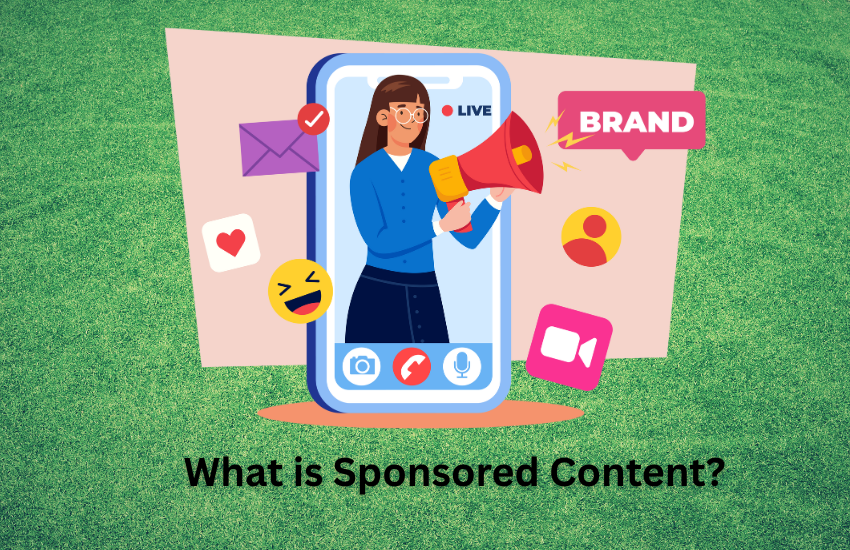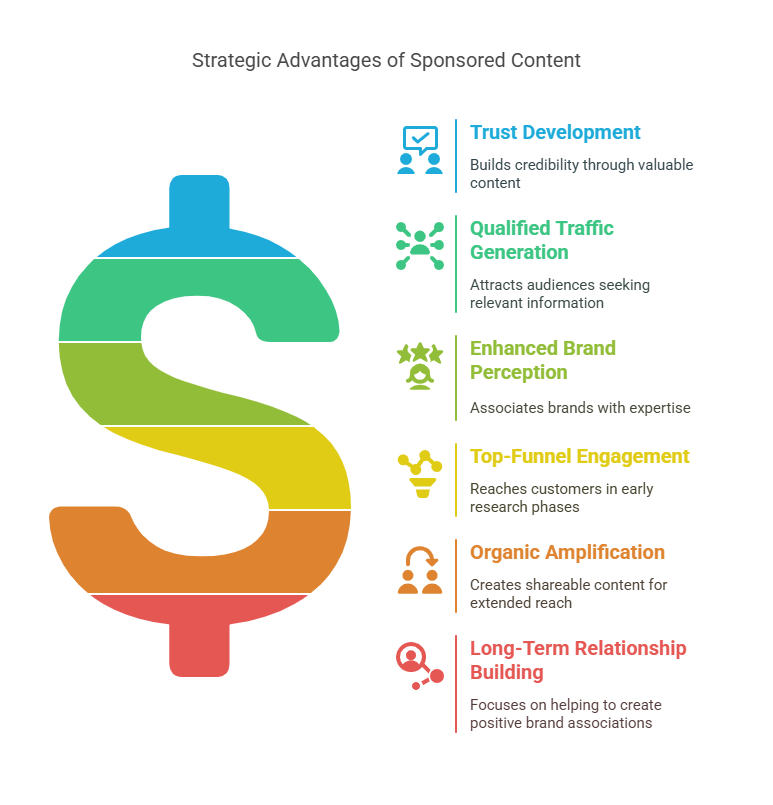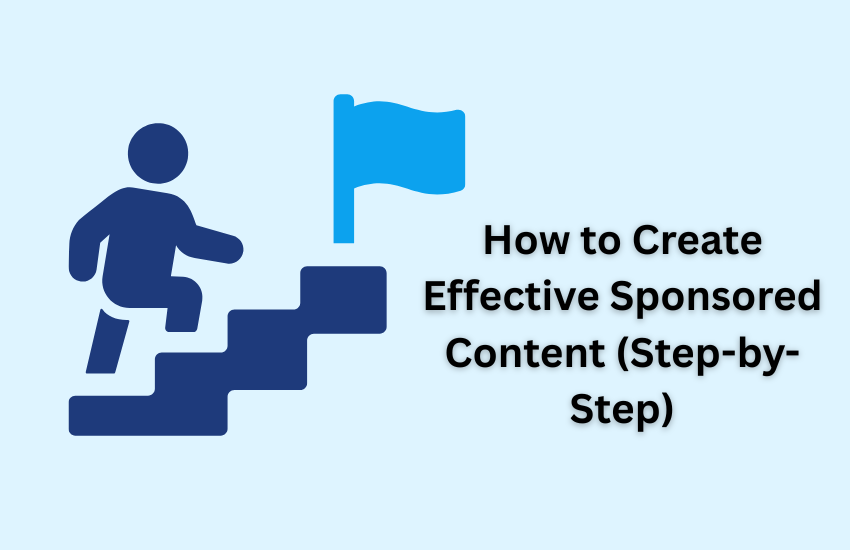Modern consumers encounter sponsored content everywhere. That Instagram post from a fitness influencer showcasing a new protein powder. The detailed investment strategy article on a financial website subtly featuring a trading platform. The comprehensive tech review video demonstrating the latest smartphone.
These examples share a common thread: they represent sponsored content that quietly revolutionizes how brands connect with their target audiences while providing genuine value.
This comprehensive guide reveals how to create sponsored content that builds trust, drives conversions, and delivers measurable results for your business.
What is Sponsored Content?

Simple Definition
Sponsored content is paid promotional material that seamlessly integrates with organic content. Unlike traditional advertising, it provides educational value while naturally introducing products or services to engaged audiences.
According to Sharethrough’s 2024 Native Advertising Report, sponsored content generates 53% more views than traditional display ads.
The fundamental difference lies in approach: traditional ads interrupt user experience, while sponsored content enhances it by delivering valuable information that audiences actively seek.
Consider a cooking blog partnering with a premium kitchenware brand to create an in-depth knife skills tutorial. Readers learn essential cooking techniques while discovering high-quality kitchen tools that enhance their culinary journey.
Sponsored Content vs. Traditional Ads
Understanding these distinctions helps marketers create more effective campaigns:
- Visual Integration: Matches platform aesthetics and user expectations
- Value-First Approach: Educates or entertains before promoting
- Transparent Disclosure: Clearly identifies commercial relationships per FTC guidelines
- Narrative Focus: Weaves brand messages into compelling stories
- Precise Targeting: Reaches audiences already interested in relevant topics
Traditional display advertising relies on interruption marketing, while sponsored content employs permission marketing by providing requested value first.
Sponsored Content vs. Native Advertising
While related, these formats serve different strategic purposes:
Native Advertising: Short-form promotional content that mimics platform appearance without extensive storytelling depth.
Sponsored Content Features:
- Comprehensive Storytelling: Develops complete narratives rather than quick promotional messages
- Extended Format: Provides substantial information through long-form articles or detailed videos
- Educational Priority: Solves problems and teaches skills before introducing commercial solutions
- Organic Brand Integration: Incorporates brands as natural story elements rather than obvious focal points
Why Sponsored Content Works
Updated Stats and ROI
Current industry data demonstrates sponsored content’s remarkable effectiveness:
- 76% of consumers prefer learning about products through educational content over traditional advertisements (HubSpot Content Marketing Report 2024)
- Sponsored content achieves 9.2x higher click-through rates than standard display advertising (Sharethrough Native Advertising Report 2024)
- Branded content increases purchase intent by 67% compared to traditional advertising formats (Nielsen Brand Effect Study 2024)
- 89% of marketers report higher engagement rates with sponsored content versus traditional advertising (Content Marketing Institute 2024)
- Content marketing generates 3x more leads while costing 62% less than traditional advertising (Demand Metric 2024)
“Sponsored content succeeds because it respects the audience’s intelligence. Instead of shouting about products, it provides genuine value that builds trust and authority.” – Neil Patel, NeilPatel.com
Key Benefits

Well-executed sponsored content delivers measurable advantages:
- Trust Development: Establishes credibility through valuable content before introducing commercial messages
- Qualified Traffic Generation: Attracts audiences actively seeking relevant information
- Enhanced Brand Perception: Associates brands with helpful expertise rather than pushy sales tactics
- Top-Funnel Engagement: Reaches potential customers during early research phases
- Organic Amplification: Creates shareable content that extends reach through social sharing
- Long-Term Relationship Building: Focuses on helping rather than selling to create positive brand associations
The strategic advantage lies in starting conversations rather than ending them, creating ongoing engagement opportunities with potential customers.
FTC Guidelines & Legal Compliance
Federal Trade Commission regulations require transparent disclosure of commercial relationships in sponsored content. Compliance protects both brands and publishers while building audience trust.
What You Must Disclose
FTC guidelines mandate clear, conspicuous disclosure of paid partnerships:
- Clear Language: Use unambiguous terms like “Sponsored,” “Paid Partnership,” or “Advertisement”
- Prominent Placement: Position disclosures at content beginning where users immediately notice them
- Simple Terminology: Avoid confusing hashtags or industry jargon that general audiences might not understand
- Mobile Optimization: Ensure disclosures remain visible across all devices and screen sizes
- Video Integration: Include both visual overlays and verbal mentions in video content
“Transparency isn’t just about legal compliance – it’s about building authentic relationships with your audience. Clear disclosures actually increase trust rather than decrease it.” – Brian Dean, Backlinko
Platforms with Specific Rules
Major platforms provide built-in disclosure tools for sponsored content:
- Instagram: Utilize the integrated “Paid Partnership” labeling system for automatic compliance
- Facebook: Tag business partners using Facebook’s branded content disclosure tools
- YouTube: Enable “Includes Paid Promotion” features plus verbal sponsorship acknowledgments
- TikTok: Include hashtags like #ad or #sponsored prominently in caption beginnings
- LinkedIn: Incorporate disclosure language within the first lines of professional posts
How to Create Effective Sponsored Content (Step-by-Step)

Step 1: Define Your Goals
Successful sponsored content campaigns begin with crystal-clear objective definition. Choose one primary goal to guide content creation and measurement:
Goal-Specific Approaches:
- Brand Awareness: Focus on storytelling and expertise demonstration that showcases industry knowledge
- Traffic Generation: Create compelling headlines and clear calls-to-action that encourage clicks
- Lead Generation: Offer valuable resources requiring contact information exchange
- Sales Conversion: Include product demonstrations and streamlined purchase pathways
Clear goal definition enables precise success measurement and campaign optimization.
Step 2: Choose the Right Partner or Channel
Partner selection significantly impacts campaign success. Evaluate potential collaborators using these criteria:
- Audience Alignment: Verify demographic and interest overlap between partner audiences and target customers
- Engagement Quality: Prioritize highly engaged smaller audiences over large disengaged followings
- Content Quality: Review previous sponsored content for natural brand integration and professional execution
- Brand Values Compatibility: Ensure partner values align with your brand positioning
- Performance History: Analyze past campaign results and audience feedback
Micro-influencers with 1,000-10,000 followers achieve 60% higher engagement rates than macro-influencers (Later Social Media Trends Report 2024).
Step 3: Craft Valuable Content
Create sponsored content that provides genuine value while naturally incorporating brand messages:
- Story-Driven Approach: Develop compelling narratives that weave brand elements into valuable information
- Platform Optimization: Adapt content format and tone to match platform-specific user expectations
- Educational Focus: Include actionable tips, tutorials, or entertainment that audiences actively seek
- Problem-Solution Framework: Address real audience challenges and demonstrate relevant solutions
- Authentic Voice: Allow content creators to maintain their natural communication style
Step 4: Add Clear CTA (Call to Action)
Guide audience members toward desired actions with strategic call-to-action placement:
- “Discover more insights about [topic] here” – Ideal for awareness-focused campaigns
- “Access our comprehensive [topic] guide” – Perfect for lead generation objectives
- “Start your free 30-day trial today” – Effective for conversion-oriented content
- “Share this with someone who needs this information” – Encourages organic reach expansion
Effective CTAs feel like natural next steps rather than abrupt sales pitches.
Step 5: Optimize for Mobile
Mobile optimization is essential since 78% of sponsored content consumption occurs on mobile devices (Google Mobile Marketing Report 2024):
- Readable Typography: Use short paragraphs and legible fonts optimized for small screens
- Fast Loading: Optimize images and videos for quick mobile loading times
- Touch-Friendly Design: Ensure interactive elements work seamlessly on touchscreens
- Vertical Format: Prioritize vertical or square video formats for maximum mobile screen utilization
- Accessible Information: Keep crucial details visible without requiring zooming
Step 6: Track and Analyze Performance
Implement comprehensive tracking to measure campaign effectiveness:
- Click-Through Rate (CTR): Measures audience action on your content
- Time on Page: Indicates genuine content engagement
- Bounce Rate: Reveals content-audience expectation alignment
- Conversion Rate: Tracks business objective achievement
- Brand Mention Tracking: Monitors sponsored content impact on overall brand conversations
- Cost Per Acquisition: Compares sponsored content efficiency to other marketing channels
Use UTM parameters and analytics tools like Google Analytics for detailed performance insights.
SEO & Sponsored Content: What You Need to Know
No-Follow Links Are a Must
Google requires proper link attribution in sponsored content to maintain search ranking integrity:
Technical Implementation:
- Use
rel="sponsored"orrel="nofollow"attributes for all paid links - Protect both publisher and advertiser from potential ranking penalties
- Maintain content credibility through transparent link labeling
Example: <a href="https://example.com" rel="sponsored">Brand Name</a>
Avoid Duplicate Content
Create original content variations to prevent search engine penalties:
- Platform-Specific Adaptation: Customize content for different audience preferences and platform formats
- Canonical Tag Usage: Specify original content sources when republishing is necessary
- Unique Value Creation: Focus on platform-specific benefits rather than identical content distribution
Use Keyword Optimization (Carefully)
Balance SEO optimization with natural readability:
- Natural Integration: Incorporate relevant keywords that audiences actually search for
- Readability Priority: Maintain content quality over keyword density
- Metadata Optimization: Enhance discoverability through optimized titles and descriptions
- Comprehensive Coverage: Create thorough content that addresses complete user intent
Pro Tips for Platform-Specific Strategies
Leverage Instagram’s visual-first environment for lifestyle and product-focused sponsored content:
- Visual Excellence: Create stunning imagery that naturally fits user feeds
- Story Features: Utilize Stories with swipe-up links for accounts over 10k followers
- Micro-Influencer Partnerships: Work with smaller accounts having highly engaged, loyal audiences
- User-Generated Content: Encourage customers to create authentic product-featuring content
- Shopping Integration: Enable direct purchasing through Instagram Shopping features
YouTube
Capitalize on YouTube’s long-form video format for detailed sponsored content:
- Product Demonstrations: Show products in action rather than just describing features
- Dual Disclosure: Include both verbal mentions and visual text overlays
- Niche Creator Partnerships: Collaborate with creators whose audiences already show product interest
- Educational Focus: Teach valuable skills while demonstrating product benefits
- SEO Optimization: Use relevant keywords in titles, descriptions, and tags
Podcasts
Utilize podcasting’s intimate medium for personal sponsored content:
- Host-Read Advertisements: Leverage host credibility through personal endorsements
- Niche Audience Targeting: Select shows with highly engaged, specific audiences
- Exclusive Offers: Provide podcast-specific discount codes for tracking and exclusivity
- Strategic Placement: Choose between pre-roll, mid-roll, and post-roll based on campaign goals
- Long-Term Partnerships: Build authentic relationships through consistent collaboration
Tailor content for LinkedIn’s professional environment:
- Industry Insights: Share thought leadership content demonstrating expertise
- Case Studies: Showcase real customer results and success stories
- Decision-Maker Targeting: Utilize LinkedIn’s precise targeting for specific job titles and industries
- Active Engagement: Participate in comment conversations your content generates
- Native Video: Leverage LinkedIn’s video features for higher engagement rates
TikTok
Embrace TikTok’s algorithm favoring entertaining, authentic content:
- Trend Integration: Incorporate viral sounds and hashtags that align with brand messaging
- Entertainment Focus: Prioritize fun, engaging content over polished advertising
- Platform-Native Creators: Partner with creators who understand TikTok’s unique culture
- Experimentation: Test different content styles to find what resonates
- Amplification Tools: Use TikTok’s Spark Ads to boost successful organic sponsored content
FAQ: Sponsored Content
How do you label sponsored content properly?
Use clear, unambiguous terms like “Sponsored,” “Paid Partnership,” or “Advertisement” at the beginning of your content where they’re immediately visible. The FTC requires “clear and conspicuous” disclosures that average users immediately understand. Avoid confusing hashtags or buried disclosures that might mislead audiences.
Can sponsored content hurt your SEO?
Sponsored content only negatively impacts SEO when you ignore Google’s guidelines. Use proper link attributes (rel=”sponsored” or rel=”nofollow”) for all paid links and create original content for each platform. When executed correctly, sponsored content can boost SEO by generating valuable, shareable content that earns organic backlinks and social signals.
What’s the best format for sponsored content?
The optimal format depends entirely on your audience preferences and platform characteristics. High-performing options include comprehensive blog posts, detailed video tutorials, engaging infographics, interactive quizzes, and informative podcast episodes. Video content consistently performs well across multiple platforms, while long-form articles excel for thought leadership. Test different formats and let audience engagement data guide your decisions.
How much should sponsored content cost?
Pricing varies significantly based on creator reach, engagement rates, content complexity, and industry niche. Micro-influencers typically charge $100-500 per post, while major publications may charge $10,000+ for comprehensive campaigns. Focus on cost per engagement or cost per conversion rather than absolute prices. A more expensive placement reaching precisely the right audience often delivers superior ROI compared to cheaper options with poor targeting.
How do you measure sponsored content success?
Define success metrics before launching campaigns. Essential measurements include click-through rates, engagement rates, brand mention increases, website traffic growth, lead generation, and direct sales attribution. Use UTM parameters to track traffic sources and conversion paths accurately. Prioritize metrics aligning with business goals over vanity metrics like views or likes.
What’s the difference between sponsored content and influencer marketing?
Sponsored content refers to the content format – paid promotional material providing value while featuring brands. Influencer marketing describes the distribution strategy using individuals with social media followings to reach audiences. You can create sponsored content without influencers (branded articles on major publications) and work with influencers on non-sponsored content. Often, they work together when influencers create sponsored content for brands.
Conclusion: Make Sponsored Content Work for You
Sponsored content represents a fundamental shift toward value-first marketing that respects audience intelligence while building genuine relationships. Success requires focusing on audience needs first, maintaining transparent communication, and consistently delivering content worth consuming and sharing.
The most effective sponsored content campaigns start with a simple question: “How can we help our audience succeed?” When you answer that question authentically while naturally incorporating your brand story, promotional elements feel organic rather than forced.
Remember these core principles for sponsored content success: prioritize value over promotion, maintain transparency through clear disclosures, adapt content for each platform’s unique culture, measure performance consistently, and focus on building long-term relationships rather than pursuing short-term gains.
Sponsored content builds trust, expands reach, and drives measurable results when approached with the right strategy. Start with small tests, analyze what resonates with your audience, and scale successful approaches while maintaining quality and authenticity.
The future belongs to brands that earn attention through helpfulness rather than demanding it through interruption. Sponsored content positions your business on the right side of this evolution.


